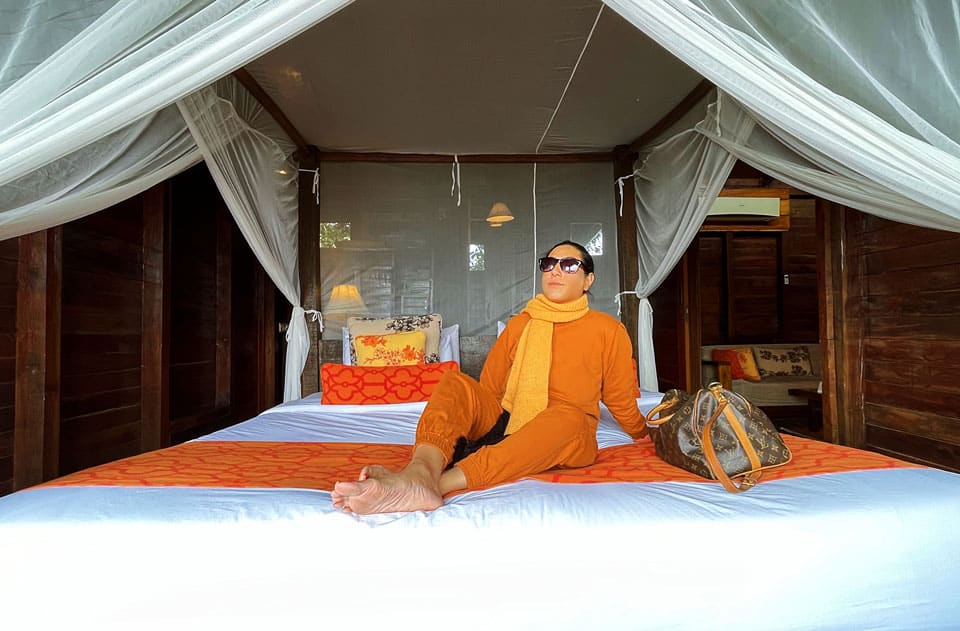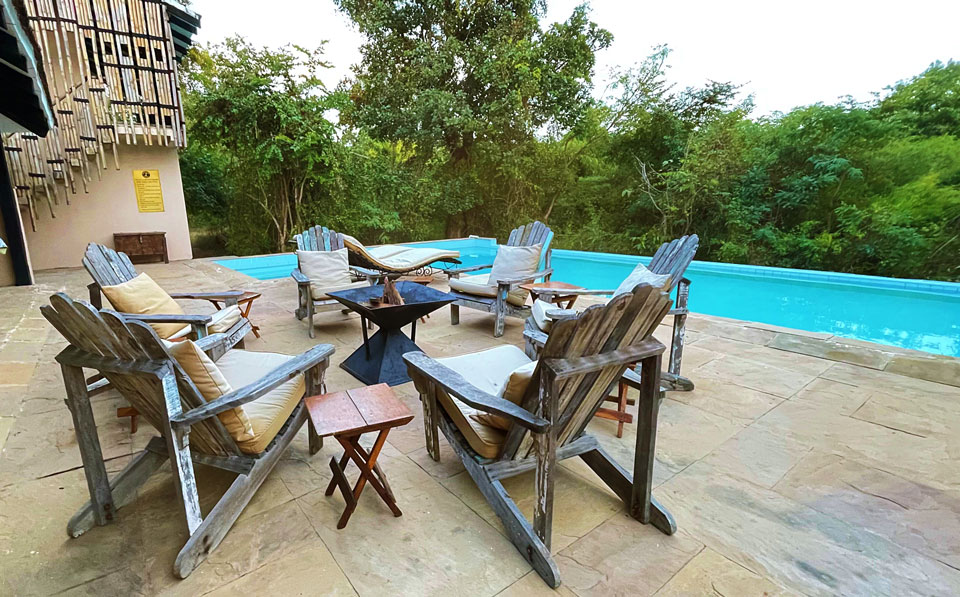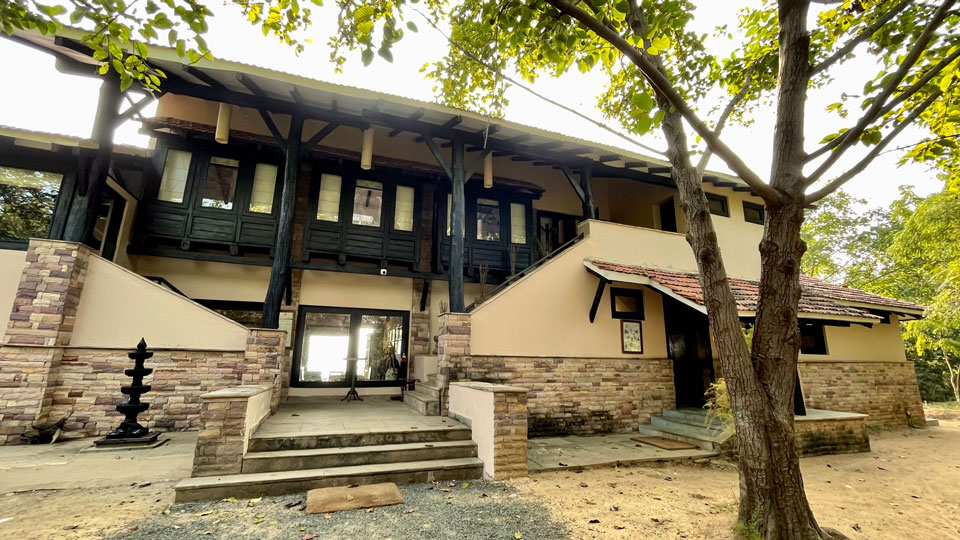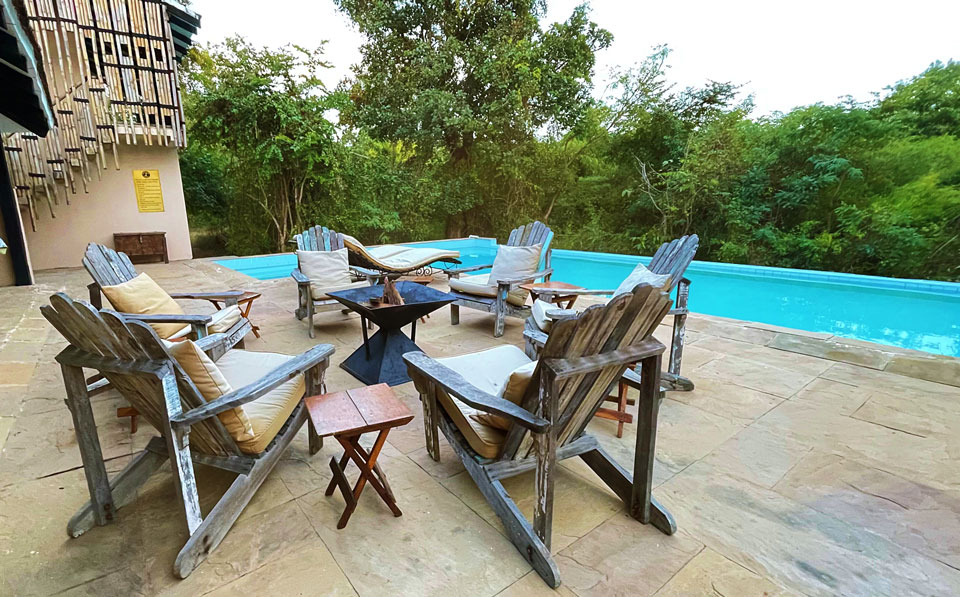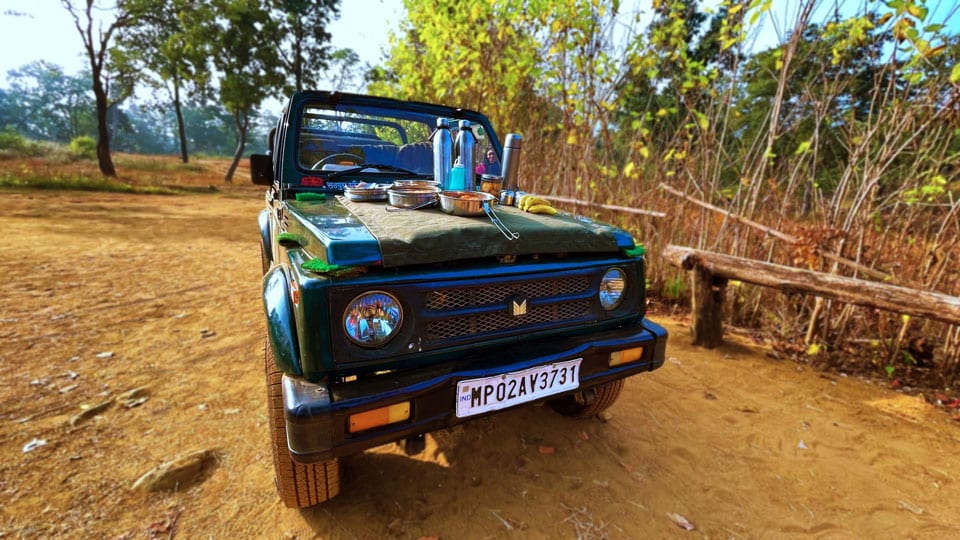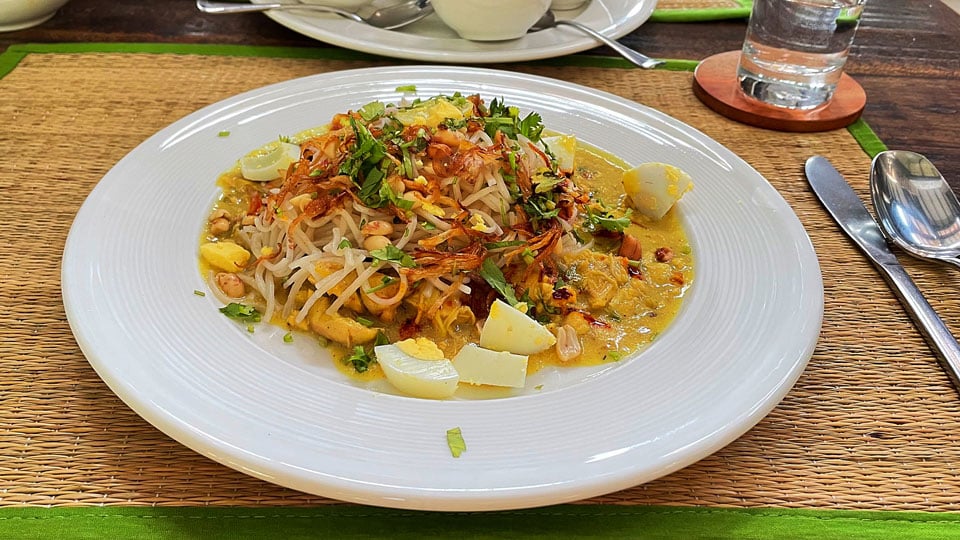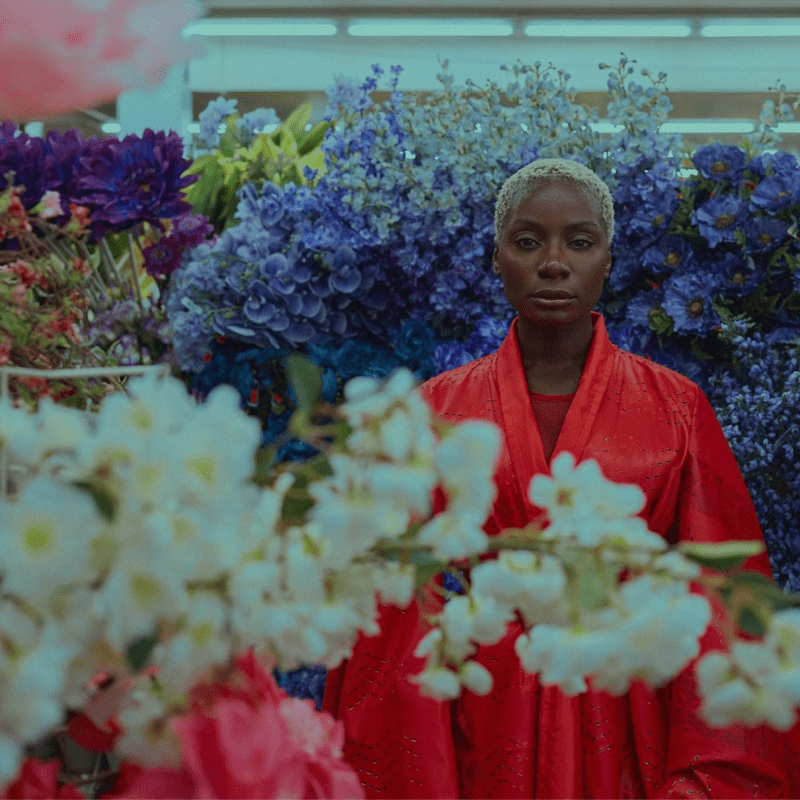I’m at Denwa Backwater Escape, a biota haven on the outskirts of Satpura Tiger Reserve. The promise of an intimate encounter with Madhya Pradesh’s less-visited bio reserve drew me into this wildlife retreat, and I grunted my way home.
I drove seven hours from Indore to Madhai on a winter afternoon. The nearest airport to Satpura National Park, however, is in Bhopal, which is only 136 kilometres away. The naturalist, Neetu Uikey, and the manager, Kshitij Gambhir, greeted me with radiant smiles.
As we walked through the pebble-laid and lantern-fringed pathway, Neetu demonstrated how the resort is committed to sustainability by gifting me a steel water bottle as a keepsake. This place has such a magical vibe – I thought as I took one step after another until I reached the welcome hut. It’s where I received a cold towel, refreshing lemon juice, and a tour of Denwa Backwater Escape’s glass-framed 3D map.
Architecture, Birds, and Malwa Thali
There are only eight cottages and one tree house! As intimate as it gets! Even though most of the architecture hides behind lush plantations, it does not go unnoticed. Saj wood used for the construction has been recycled from discarded railway track timber. The main building, however, is the focal point as it houses a souvenir shop, an office and an in-house restaurant. Denwa Backwater Escape discourages room service because food particles attract rodents.
I’m staying in treehouse 09 because it overlooks the river and has everything I need for an authentic wildlife experience. Tree houses 09 and 10 were interconnected by a wooden partition, but I had both to myself because no other guest had inhabited the other. As I stroll from my room to the main building, my gaze is fixed on the sky. Nature’s architecture blooms with a hive of colourful birds and foliage seeded by the universe on this walk through paradise.
But, before I checked in at 3 pm, I let my senses spin over the authentic Malwa Thali waiting for me at the restaurant. A Malwa Thali is an ideal welcome to Madhya Pradesh. This restaurant’s wooden furnishings and fireplace contribute further to the magic of the retreat. The sun shines brightly through it during the day, and at night, it transforms into a cosy refuge. Shortly, the waitstaff brought a thali with several pannikins.
These held Khad Murgh, Moong Dal Badi Chaat, Indrahar Kadhi, Sev Tamatar ki Sabji, and Aloo Chokha. In the centre were Dal-Bati-Churma, steaming rice, and accompaniments such as papad, achar (pickle), and Lehsun (garlic) chutney. The Malwa lunch concluded with a Nariyal Chana Bati and homemade Paan ice cream for dessert. I couldn’t have asked for more authentic flavours on a chilly afternoon! The Indrahar Kadhi, Khad Murgh, and Paan ice cream were hands down the standouts!
That House on a Tree
Something about a treehouse evokes childhood memories. It’s a happy place. Perhaps because it is the closest one can get to experiencing raw nature. Because it’s December, the Denwa River is rung by lush flora. For roughly $300 per night, this tree house is a utopia interweaved by a childlike charm and state-of-the-art innovation. This house on the tree carries ingenuity, which makes Denwa Backwater Escape by Pugdundee Safaris an inspiration for Madhya Pradesh.
Every detail, from fitted fabrics to secret nooks and unexpected tribal artwork, artistically combines the energy with the natural attractions of the Satpura Tiger Reserve. The interiors are a delight to embrace, with colourful pillows, a bed dressed in premium linen, windows covered in beige rolling curtains, a dustbin neatly lined with a newspaper, ample charging points, a separate living area, a superb twin basin washroom, and a work desk.
The exteriors feature a porch with stunning views. Monkeys, deer, wild boar, and birds visited me frequently. Oscillating trees, the jollity of monkeys, dramatic birds, and the Denwa River rushing by – I could easily sit here for hours and take in this extraordinarily peaceful and stunning scenery.
There is a reason why the phone network is so sparse in this area. Nature wants you to be left alone. Jio is the only phone network that works here. The internet dongle in the tree house otherwise is helpful if you need to connect to Wi-Fi. The wilderness began to slink in as I noticed deer and wild boars wandering on the backside of this riverfront treehouse! However, Kshitij had an even better adventure in store for me.
Sunset from a Boat
How often do we get to watch a sunset from a boat? It was a rare treat, and I couldn’t be happier to sail into the waters of the spectacular Denwa river on the day of my arrival. As luck had it, Denwa Backwater Escape launched their boat ride on the same day I checked in. So I was one of their first few guests to sail around the Tawa reservoirs.
We walked down a rugged slope to the disembarkation point. From there on, we sailed to a nearby checkpoint, where we picked the guide and went deeper into Satpura’s dreamlike riverscape, which changed every few minutes. On this two-hour boat ride, I spotted Darter birds, Emerald Doves (Chalcophaps Indica), a tree full of cormorants, great cormorants with white beaks, little egrets, black and white pied kingfisher, white-throated kingfisher, Bechtel bird, and red wattled lapwing.
We also saw one adult and one baby crocodile. Neetu was prompt to inform me that these waters are only home to freshwater marsh crocodiles. When I asked how many there were, she said, “There could be more than 1000. On a single boat ride, one can easily spot 20-25 crocodiles. Most are visible in the winter as they sunbathe near the banks.” The sun began to set as we moved deeper into the river, and I have to admit that it was one of the most exquisite sunsets I had seen in a long time. It was a sight to behold as the fisherman in the distance threw their fishing nets into the river.
Responsible Tourism and Dinner by the Fireplace
Later that evening, when I left my tree house for dinner, a guard with a torch awaited me downstairs to accompany me to the restaurant. It occurred throughout my stay. I honestly believe that with such gestures, be it caring for guests, using glass bottles, or keeping the surroundings trash-free; Denwa Backwater Escape distinguishes itself as a responsible eco getaway. At 7.30 p.m., the place dropped quiet, lanterns beamed, and the aroma of the food drew me to the table next to the fireplace.
Not only was the ambience warm so were the food and the service. Dim sum, Makai kabab, and Murgh Tikka were served as appetisers. Tomato Sorba, Bengali Fish Curry, Palak Paneer, Beans Dal Poriyal, Khatta Meetha Kaddu, and Lauki Dal Tadka as the main course. The meal concluded with a date cake topped with ginger sauce and homemade cinnamon ice cream. As the temperature fell, I coupled dinner with a Leopard Claw cocktail, which kept me warm all night.
Nature Walk, Cycling, and Adivasi Thali
Mornings were magical at this rustic treehouse. A lovely breakfast at the riverfront restaurant started my second day. After that, I went on a nature walk and rode a bike around the grounds. My schedule now included early morning and late evening walks in this plastic-free zone with Neetu, who has been working as a naturalist with Denwa Backwater Escape for over a year.
She has spotted 200 – 250 different bird species in this time. She tells me that she looks at the eyes, beak, colour, wing pattern, and feet and listens to their sounds to determine the species and gender of the birds. We saw Tailorbird, Iora, Sunbird, rufous treepie, tailed Drongo, and spotted and red-billed hornbills while we talked and walked. Hornbills can be seen all day. Two to three riverside crocodiles come close to an adjoining island but not at the property as many people stay there.
The main event today, however, was lunch, as I was really looking forward to getting my hands dirty with some authentic Madai cuisine. Madai Adivasi Thali was a blast of flavours! Singhara salad, earthy smoked cottage cheese and fish in mahua leaf, Pan Bada curry, Gilki Chokha, Suki Bhaji, Kadam ki chutney, Adiwasi Dal, and unpolished steamed rice with Bajra roti, and Kikkad roti made up the thali. I gorged on Bajra Gud Halwa and homemade Anjeer ice cream for desserts.
I spent the rest of the day admiring the breathtaking vistas from the eco-friendly treehouse. The evening closed with a wildlife documentary by the poolside around a bonfire to cast more insights into the region, as this treehouse merged the dynamics of Satpura with the whims of Pugdundee Safari. Later at the restaurant, Achari Paneer Tikka, mini pizza, and chicken seekh kabab graced the table for appetisers. The main course featured veg soup, fish en papillote, chicken pesto pasta, and sautéed vegetables.
Fish en Papillote, a simple baked fish on parchment, turned out to be the standout. Chef Vijay Laxmi used fresh river sole fish for Fish en Papillote, and I have to say it was the most sumptuous river fish I’ve ever had. It’s boneless and soft, and it melts on your tongue. The dinner rounded off with apple pie and homemade cinnamon ice cream.
Satpura Tiger Reserve – Wildlife Sighting
At 6 a.m. the next morning, we went on an early safari while the sky was dark and the moon and stars were still visible. Neetu brought me a blanket and a hot water bag to keep me warm. Since Satpura Tiger Reserve is on the other side of the Denwa river, we had an open jeep safari from DBE to the boat disembarkation point. Because it was winter, the Denwa river was overflowing, and we had to navigate it by boat. However, it was only a 10-minute sail.
On the other hand, when we arrived at the jeep safari parking area at 6.30 a.m., about five other jeeps were waiting to venture into the forest. Wildlife photographers were carrying sizeable cameras. Their enormous lenses and the prospect of what I was about to see made me ecstatic. Soon after, our safari joined the pageant. As we approached the forest, the drivers of the passing cars exchanged numbers, referring to the tracks.
The woods were wild, even though the trip was not bumpy. We travelled three times through trails, over cliffs, and zoomed across canals before seeing our first animals of the day. A big Sambar (deer) was strolling down the foot trail. Our safari remained parked behind it for a few minutes before it vanished into the bushes.
Next, we saw a tiger paw mark on a trail, indicating that the big cat had recently traversed this road. We decided to wait, after Neetu, the naturalist, rapidly validated the information with other safari drivers. As we waited, Neetu and Kshitij exchanged several forest stories, and their devotion to Satpura Tiger Reserve will spark anyone’s interest. Before halting for breakfast at the langur-overrun campsite, we did a few more laps in the forest and glimpsed deer, peacocks, and wild boars.
As I steered around, Neetu and Kshitij set up a feast for me on the front body of the jeep. They brought me boiled eggs, fruits, muffins, stuffed paranthas, cinnamon rolls, tea, and coffee, among other things. Following breakfast, we scanned the forest for more sightings.
The winter shivers dissipated as the sun shone brightly at 11 a.m., and it was time to return to the eco-escape. But on the way back, we chanced upon sloth bears, respectively a mother with her two babies. They were scouring termite nourishment in the shrubs. It was overwhelming to see them this close! While we couldn’t see the tigress with her cubs, the fact that she was close was thrilling in and of itself.
A Burmese Lunch and a BBQ Dinner
Lunch was Khow Suey, a Burmese delicacy. It’s a complete meal with boiled noodles, gravy, chicken keema, chilli oil, boiled egg, peanuts, and fried onions, served with a lemon wedge. The key to eating this is to mix everything before digging in. The toppings were excellent. And the desserts, especially the Ghewar with rabdi and chocolate ice cream, lured me in.
I went for a nature stroll near the Denwa river in the early evening. Neetu would stop as we walked to tell me about the surrounding flora and to point out hornbills and giant wood spiders. This walk taught me a great deal about Satpura, Madai, and the Denwa River. When I returned to my treehouse, the deer were grazing their way toward the river, the birds were flying home, the monkeys had gone to the riverfront trees, and I was left to sit and enjoy the magical sunset.
While we did not see the tigress during the day, her roar resonated across the woods in the evening and was audible on the property. The roar was then notified by a siren.
An hour later, I stopped by the poolside, where the Denwa Backwater Escape culinary team was preparing a poolside BBQ dinner for me. The fire charred the round metallic vessels, swimming pool in the background foraged subtle blue hues as the kitchen staff barbecued meat, fish, and cottage cheese. Tonight’s meal was a Lebanese-inspired BBQ – generous portions varied to my delight.
I paired my meal with Jungle Tea on the side, a cocktail infused with tea and rum that kept me warm all night. I sat there, enjoying the warmth of the fire, and later that night, I slept to a starry sky view. My stay at the Denwa Backwater Escape was coming to a close after four fantastic days, and I genuinely wished it hadn’t. I departed for Bhopal after a hearty breakfast of pancakes, french toast, Chila, and appams the following morning.
Denwa Backwater Escape is worth a visit since it is lush and verdant, surrounded by trees. Ideal for wildlife enthusiasts. In fact, those unable to embark on a safari can still appreciate the property’s diverse flora and animals. On the property alone, over 169 different types of birds can be seen. This eco luxury retreat has recently completed 11 years of coexisting with wilderness.
Most inhabitants in nearby villages make their living through farming. Neetu told me that Mahiri, a rice preparation with Mahir, signifying Chaas or buttermilk, was eaten by previous generations in neighbouring villages. The favourite meals of the locals from the surrounding regions are Dailya (porridge) with Ghee, Aloo Bata, cauliflower, and Dal Baati Churma. Most villagers cultivate chillies, potatoes, Saimi, ridged gourd, sponge gourd, and bottle gourd in their backyards, and you might even be able to purchase some fresh veggies on your way back.
Written by Veidehi Gite.
Which are the healthiest countries in the world for 2023?
A New Model Might Help Us Understand Societal Change, Conflict, and How We Can Shape Our Future by Justin Bean.
How SMBs Can Communicate Sustainability Initiatives to Consumers by Jane Marsh.
Big Companies Need Startups – and Vice Versa by Howard L. Wolk.
Track Latest News Live on CEOWORLD magazine and get news updates from the United States and around the world.
The views expressed are those of the author and are not necessarily those of the CEOWORLD magazine.
Follow CEOWORLD magazine headlines on: Google News, LinkedIn, Twitter, and Facebook.
Thank you for supporting our journalism. Subscribe here.
For media queries, please contact: info@ceoworld.biz
























































![Key Metrics for Social Media Marketing [Infographic] Key Metrics for Social Media Marketing [Infographic]](https://www.socialmediatoday.com/imgproxy/nP1lliSbrTbUmhFV6RdAz9qJZFvsstq3IG6orLUMMls/g:ce/rs:fit:770:435/bG9jYWw6Ly8vZGl2ZWltYWdlL3NvY2lhbF9tZWRpYV9yb2lfaW5vZ3JhcGhpYzIucG5n.webp)


